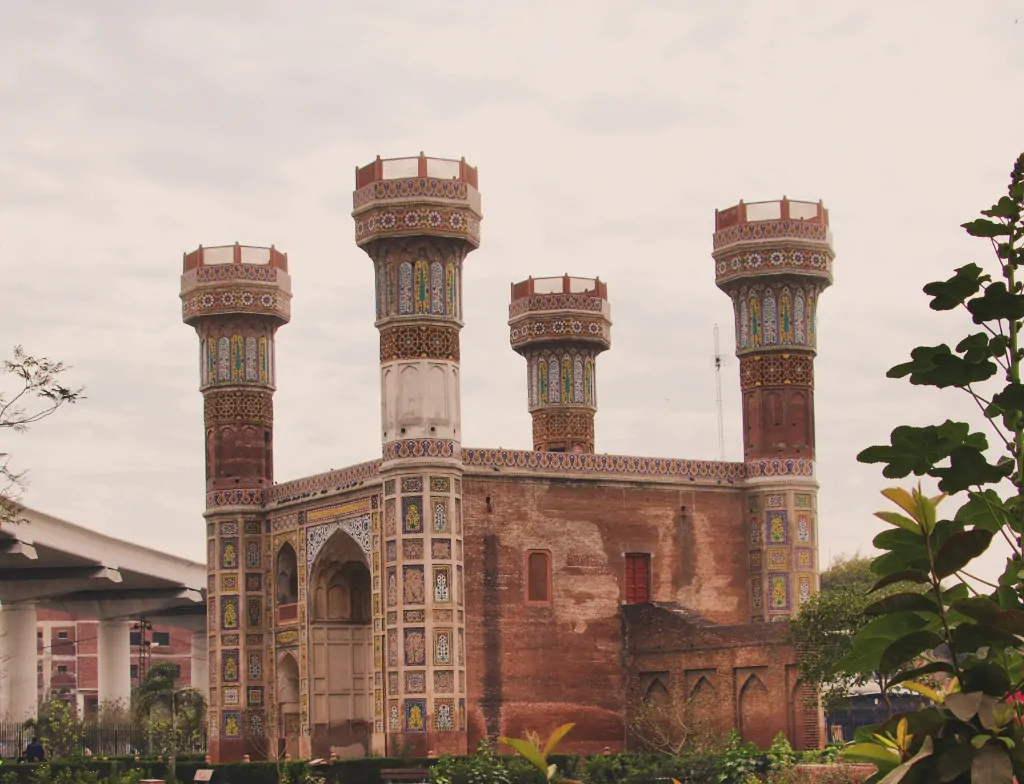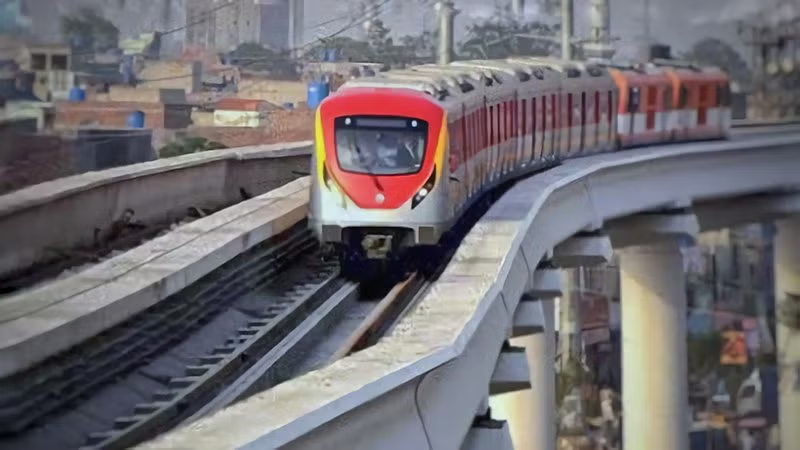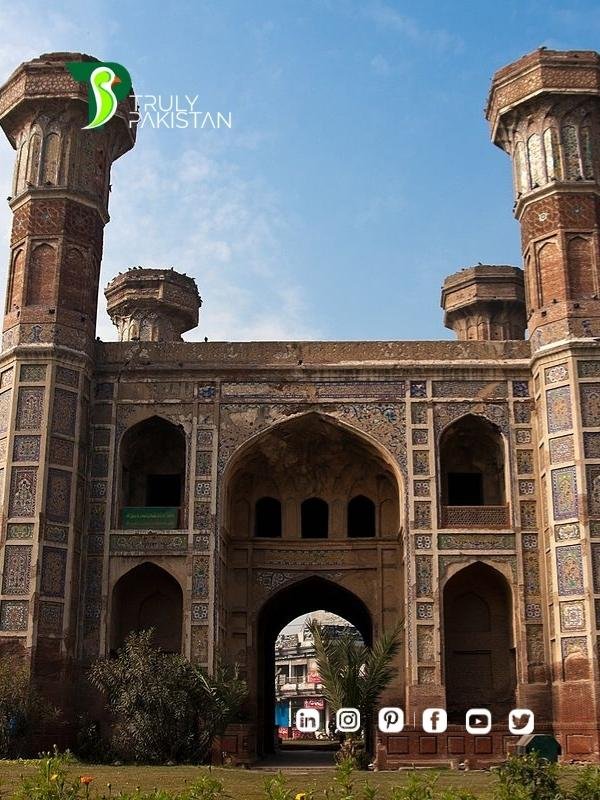Chauburji Chowk: History, Architecture, Access & Local Guide


Chauburji Chowk is a Mughal-era gateway (1646) that once marked the entrance to a charbagh garden in Lahore. Today it stands at a busy junction yet remains a protected heritage landmark and a concise lesson in tilework, calligraphy, and urban change.
Table of Contents
What is Chauburji Chowk?
In simple terms, Chauburji (“four towers”) is a brick-and-tile gateway from the reign of Shah Jahan. It anchors a major crossroads—Multan Road and Bahawalpur Road—and gives the neighborhood its name. Built 1646 (Shah Jahan period) — see concise history Original role Entrance to a Mughal charbagh garden; the garden has not survived Location Central Lahore, at Multan Rd × Bahawalpur Rd (map overview) Protection Listed under Punjab heritage laws (regulatory reference) Why it matters Signature kashi-kari (glazed tiles), Quranic/Persian inscriptions, rare surviving garden gateway type in Lahore
Chauburji Chowk at a glance
- Three standing octagonal towers today; one was lost in the 19th century.
- Façade carries calligraphic panels and geometric tile mosaics—many sections are restored or fragmentary.
- Standing at a live traffic island, so short, careful visits work best.
Map & coordinates
Drop a pin near the traffic circle where Multan Road meets Bahawalpur Road. For quick orientation, use an offline map and the Orange Line Metro “Chauburji” stop as your anchor (official tourism brief).
Pro tip: Plot a walking line from the station to the island and identify safe crossing points in advance (internal guide: Lahore Metro Guide).
Protected status of Chauburji Chowk
The gateway is recognized as a special premises/heritage site by provincial authorities. Conservation guidance has emphasized vibration and visual-buffer controls due to nearby infrastructure (UNESCO mission note).
For a methods-focused view of documentation and conservation, see the HBIM case study on Chauburji (technical paper).
The Mughal story behind Chauburji Chowk


Chauburji belongs to Lahore’s garden-gateway typology—small in footprint, big in symbolism. It framed processional movement from the street into a planned landscape and signaled elite patronage through tilework and scripture.
1646 construction of Chauburji Chowk
Dates on inscriptions and period sources place the work in 1646. Attribution in popular lore sometimes mentions Princess Zeb-un-Nisa; scholarly treatments note the debate and focus on the broader Shah Jahan garden program (architectural profile).
Architectural hallmarks at Chauburji
The architecture of Chauburji merges function and ornament in the classic Mughal sense. Its plan features a pointed central arch flanked by recessed panels and four minarets (burj) that give the structure its name. Only three survive today.
- Tilework: Kashi kari in blue, green, and white glazing on red brick—typical of mid-17th-century Lahore.
- Calligraphy: Persian and Qur’anic inscriptions across the façade; the most cited verse prays for the garden’s everlasting bloom.
- Materials: Brick masonry with lime mortar and faience tile inlay.
- Influence: A blend of Timurid and Persian geometric logic with Shahjahani proportions.
For visual reference, compare Chauburji’s ornament with Wazir Khan Mosque’s tiles (Wikipedia) to appreciate its shared color grammar.
The lost garden linked to Chauburji
The gate once opened into a charbagh—an enclosed four-quarter garden irrigated from the Ravi floodplain. Over centuries, river course shifts and urban spread erased the layout, leaving the gateway isolated. Early British surveys marked fragments of embankments east of the monument (archival photos).
Damage, conservation & current condition of Chauburji Chowk
Time, traffic, and nearby construction have all tested the structure. Yet it remains one of the most photogenic symbols of Lahore’s resilience.
Earthquakes & missing minaret at Chauburji
An 1843 earthquake brought down the south-west tower. Old photographs show partial collapse and later brick patching, evidence of ad-hoc repairs before formal conservation began.
Restoration timeline of Chauburji
- 1960s–70s: Basic stabilization by Punjab Archaeology Department.
- 1985: Listed under the Punjab Special Premises Ordinance (legal protection).
- 2010s: Surface cleaning, tile re-fixing, and consolidation funded through provincial heritage grants.
Contemporary studies highlight the use of digital scans and Building Information Modeling to guide conservation (HBIM case study).
Metro/Orange Line impacts near Chauburji
The Lahore Metro Orange Line passes within meters of the monument. UNESCO assessments warned of vibration risks and visual intrusion, prompting protective retaining walls and continuous monitoring (UNESCO report).
Public debate over the project drew rare consensus: urban growth must adapt to heritage, not the other way around. Community volunteers now report cracks and vegetation so authorities can respond quickly.
Getting there: transport & on-site tips around Chauburji Chowk
Visiting Chauburji is straightforward if you plan for Lahore’s traffic and short daylight windows for photography.
Metro & bus access to Chauburji


The easiest route is the Orange Line Metro. Disembark at the Chauburji Station; from there, a five-minute walk leads to the monument’s base. Rickshaws and buses also converge from Anarkali and Mozang. For digital navigation, check Waze live map.
Accessibility at Chauburji
There is no dedicated ramp or tactile paving; expect uneven ground and curbs. Visitors with mobility challenges may prefer viewing from the station overpass where the entire façade is visible. Heritage advocates have recommended low-impact ramps and shaded benches—updates are pending.
Local life near Chauburji
- Food: Early morning tea stalls and evening barbeque kiosks cluster on Multan Road.
- Photography: The best light falls between 7–9 a.m. when traffic is lighter.
- Etiquette: Avoid stepping onto plinths or touching tile fragments; fines apply under heritage law.
Combine the stop with a short circuit to Old Lahore Walk for a richer heritage route.
Photo & timeline gallery of Chauburji Chowk
Seeing Chauburji Chowk evolve through centuries tells as much about Lahore’s urban history as about Mughal aesthetics. Historic photos and modern restoration shots reveal both loss and endurance.
Before/after Chauburji Chowk
Compare 19th-century lithographs showing four intact towers with today’s three-turret silhouette. The restored brick joints, lime plaster infill, and newer tile sections are easy to spot. You can browse side-by-side images on Wikimedia Commons or vintage collections on Alamy.
Feature checklist at Chauburji Chowk
- Central Arch: Pointed, fluted, and recessed with decorative voussoirs.
- Three surviving towers: Octagonal, capped with small domed kiosks.
- Tile Bands: Floral motifs, arabesques, and Kufic inscriptions in turquoise and cobalt.
- Persian Inscription Panel: Mentions the year 1056 A.H. (1646 A.D.).
- Brick Bonding: Alternating rows of red brick and glazed faience mosaic.
Each detail shows why Chauburji remains a critical case study for conservation programs in Lahore’s humid climate.
Mini timeline of Chauburji Chowk
| Year | Event |
|---|---|
| 1646 | Construction during Shah Jahan’s reign; gateway to royal garden. |
| 1843 | Earthquake damages south-west tower. |
| 1890s | Photographed in British survey albums. |
| 1965-70 | First structural stabilization by Punjab Archaeology. |
| 1985 | Declared protected under Punjab Special Premises Ordinance. |
| 2015-17 | UNESCO reviews Orange Line metro proximity impact. |
| 2020-Present | Ongoing tile restoration and environmental monitoring. |
FAQ — quick answers about Chauburji Chowk
What is Chauburji Chowk known for?
It’s known as a Mughal garden gateway featuring signature glazed tiles and Quranic calligraphy, symbolizing the “four towers” of its name. Its fusion of art and urban presence makes it one of Lahore’s best-known heritage icons.
Who built Chauburji Chowk and when?
Inscriptions date its construction to 1646 A.D., under Emperor Shah Jahan. Patronage is sometimes linked to Princess Zeb-un-Nisa, though evidence remains inconclusive. The monument’s style aligns with Shahjahani architecture of mid-17th-century Lahore.
Where is Chauburji Chowk in Lahore and how to reach it?
Located at the intersection of Multan Road and Bahawalpur Road, the site is a five-minute walk from the Orange Line Chauburji Station. Use digital navigation like Waze or Mapcarta for precise routing.
Is Chauburji Chowk still under restoration or at risk?
Conservation continues under the Department of Archaeology Punjab. UNESCO assessments classify it as stable but sensitive due to metro-line vibration. Public reporting and digital monitoring keep oversight active (UNESCO source).
What architectural style is visible at Chauburji Chowk?
The monument exemplifies late-Mughal architecture with Indo-Saracenic and Timurid influences—arched recesses, Kufic bands, and domed kiosks—all adapted to Lahore’s local materials.
Nearby landmarks & further reading from Chauburji Chowk
Walkable Mughal sites near Chauburji Chowk
- Gulabi Bagh Gateway — another garden entrance in northern Lahore.
- Wazir Khan Mosque — a 10-minute drive for continuous tilework study.
- Shalimar Gardens — the grandest surviving charbagh.
Authoritative sources on Chauburji Chowk
For rigorous background and policy context, consult:
- Punjab Tourism official page
- Heritage Building Information Modeling paper
- Oriental Architecture database
- Wikimedia Commons gallery
Conclusion & CTA for Chauburji Chowk
Chauburji Chowk endures as Lahore’s meeting point between heritage and modernity. Its tiles mirror an age of poetic architecture; its traffic hum tells the story of a living city. Whether you stop for five minutes or linger with a camera, every angle reveals another layer of Lahore’s timeline.
Related Post: Tomb of Jahangir Lahore: History, Architecture & Hours


Author: ZunNurain Khalid — Travel & Tourism Specialist, Founder of ExploreX Pvt. Ltd., and advocate for sustainable tourism in Pakistan. With over a decade of experience in digital marketing and destination branding, ZunNurain has worked extensively on promoting Pakistan’s natural and cultural heritage.

